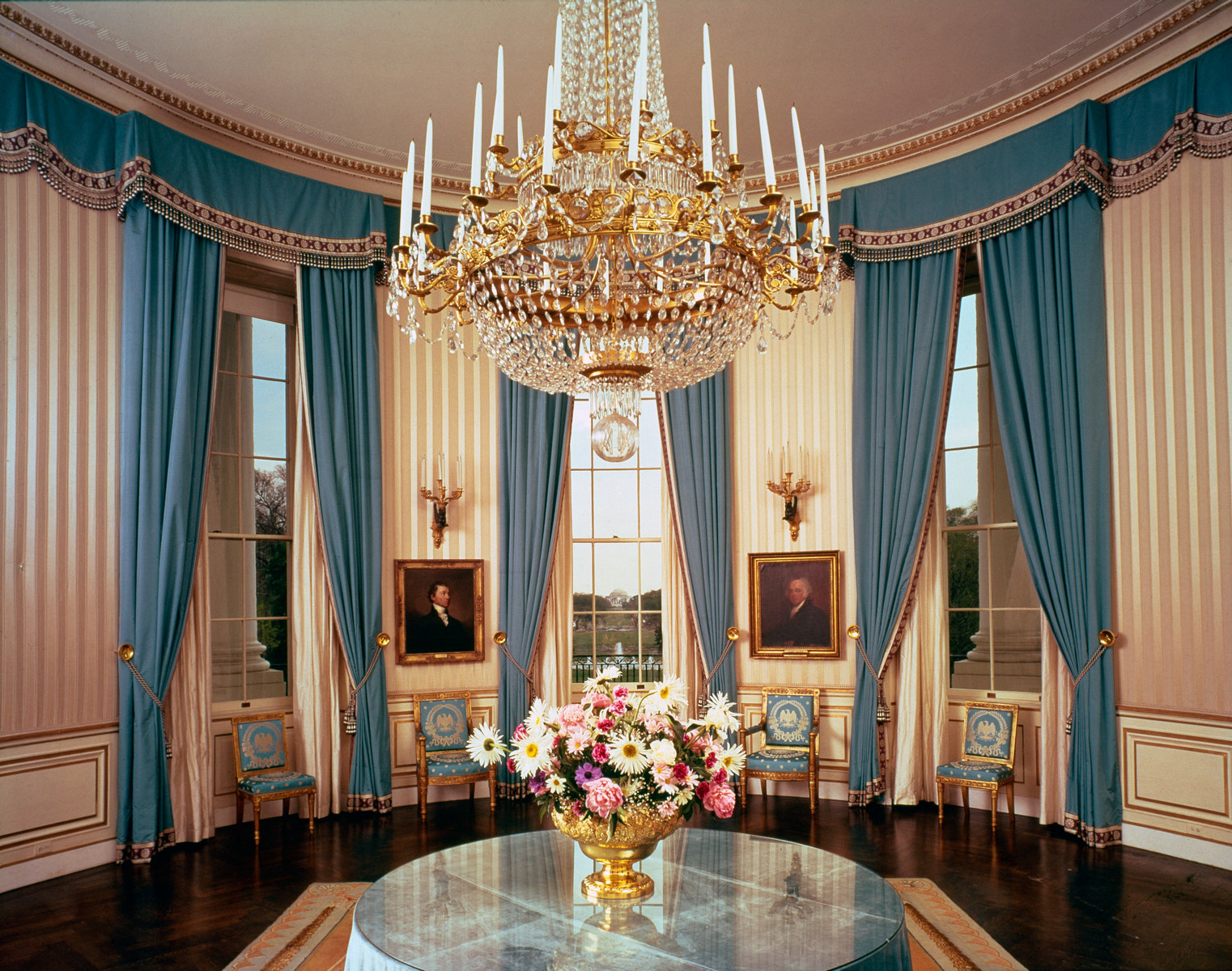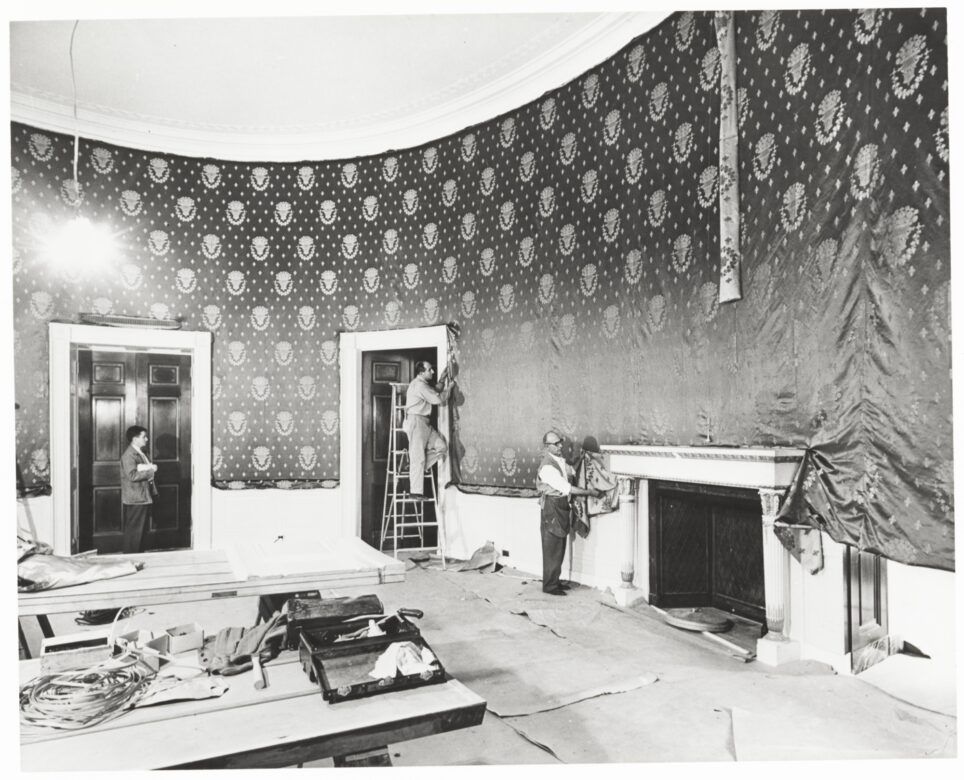Podcast Jacqueline Kennedy: Restoring the White House
When First Lady Jacqueline Kennedy took on the herculean task of restoring the interior of the White House, she appointed...
Main Content
The Blue Room with the Yellow Oval Room above and the Diplomatic Reception Room below it, form the most elegant space of James Hoban's plans for the White House. For the south wall of the Blue Room, he designed French doors flanked by long windows. An oval portico with curving stairs that descended to the South Lawn was included in these original plans, but was not built until 1824. For expediency President John Adams used the space for a south entrance hall, as he occupied an unfinished house. Since the time of President Thomas Jefferson, this oval room has been used for receptions. However, the room has not always been blue. First Lady Dolley Madison preferred bold red velvet draperies for the "Oval Drawing Room" and her architect Benjamin Latrobe custom-designed a suite of Grecian-inspired furniture with crimson cushions. The interiors and furniture were destroyed in the fire of 1814.
President James Monroe moved back into the house in 1817 after its restoration and redecorated the "Large Oval Room" in the French Empire style. Monroe ordered mahogany furniture from Pierre-Antoine Bellangé predominantly for formal use in the Oval and State Dining Rooms. However, the president's agents, the American firm of Russell and La Farge in LeHavre, France, shipped fifty-three pieces of carved and gilded beechwood furniture with crimson silk upholstery. They informed the president that "mahogany is not generally admitted in the furniture of a Saloon, even at private gentlemen's houses."

One of the results of First Lady Jacqueline Kennedy's historical research was the placement of French furniture, originally ordered by President James Monroe in 1818, in the Blue Room.
White House Historical AssociationRed dominated the room's design when John Adams II, the son of President John Quincy Adams, married Mary Catherine Hellen here on February 25, 1828. Andrew Jackson fitted the room out in green. Martin Van Buren redecorated the "Elliptic Saloon" and started the tradition of a "Blue Room" in 1837. In 1848, gas lighting was piped to all the chandeliers on the State Floor except the Blue Room. Sarah Polk thought candles looked better in Monroe's luster, an elegant fixture that was reputed to have belonged to Napoleon. She was vindicated when on the first night that it was used, gas ran out and all went dark except the candlelit oval room.
In 1860, President James Buchanan sold the Bellangé chairs and sofas at auction and replaced them with a Victorian Rococo Revival suite that served into the Theodore Roosevelt administration. In 1882 President Chester Arthur commissioned Louis Comfort Tiffany to redecorate several State Rooms. Tiffany tinted the walls of the Blue Room in a light green "robin's egg blue" which became lighter toward the ceiling and culminated in an ivory and silver frieze of hand-pressed paper. The Rococo Revival furniture was kept and reupholstered in blue silk canvas. Grover Cleveland - the first president to marry in the White House - wed Frances Folsom in the Blue Room in 1886.

President Grover Cleveland and Frances Folsom are married in the Blue Room, 1886.
Library of CongressIn 1902, Theodore Roosevelt hired McKim, Mead & White to renovate the White House. Charles McKim restored the Empire décor and designed a set of furniture comparable to the Bellangé originals. The walls were covered with heavy, steel blue ribbed silk, woven to match a sample from the Napoleonic era. In 1948, the chandelier in the Blue Room tinkled a warning that the interior structure was in a shaky condition. President Harry Truman directed a major renovation that reconstructed the interior of White House on a new foundation and steel frame. In the rebuilt Blue Room, project architect Lorenzo Winslow restored James Hoban's original cornice design and continued McKim's silk wall coverings. In 1962, Jacqueline Kennedy directed the room's redecoration, covering the walls with a cream-colored satin. By that time, the White House had acquired three of the original Bellangé chairs auctioned off in 1860, from which copies were made. Ten Bellangé pieces have been recovered to date and share the room with several reproductions.

First Lady Frances Folsom depicted in the Blue Room. Peter Waddell, Something Blue, oil on canvas, 48 x 56.
Peter Waddell for the White House Historical AssociationOn the mantle is a bronze-dore clock bearing the figure of the Carthage general Hannibal. The clock, made by French bronze casters Deniere and Matelin, was one of a pair bought by Monroe in 1817. Monroe also acquired three marble busts—Amerigo Vespucci, Christopher Columbus, and George Washington—all made by the Italian sculptor Giuseppe Ceracchi.
Paintings of presidents are also on display. John Tyler's 1859 portrait by George P. A. Healy is one of the finest in the White House Collection. Ander Zorn's portrait of President William Howard Taft shows the Blue Room of 1911. An 1819 portrait of James Monroe by Samuel F. B. Morse, who later patented the telegraph, hangs prominently in the room.

The Blue Room during the Truman renovation, 1952.
The Blue Room still serves as a reception area, most notably during the holidays, when adorned by the official White House Christmas tree. Many distinguished guests have been received here. In 1822, James Monroe had tea and cake with chiefs of the Great Plains Indian tribes. In 1878, Rutherford B. Hayes accepted the credentials of the first Chinese minister to the United States. The Blue Room has also welcomed at least one child. During the Dwight Eisenhower administration, the christening of granddaughter Mary Jean within these curving walls reminded the country that the White House is more than an icon of the presidency — it is home to a family.

This photograph of the Blue Room was taken in 2010 during the Barack Obama administration.
White House Historical AssociationWhen First Lady Jacqueline Kennedy took on the herculean task of restoring the interior of the White House, she appointed...
Over 200 years ago, James Hoban left Ireland for America to pursue his dream of becoming an architect. Selected by President...
Since 1965, the White House Historical Association has been proud to fund the official portraits of our presidents and first ladies,...
Many people approach the decor of their homes as a reflection of oneself. But what happens when a home's interior...
James Hoban came from humble beginnings as a young carpenter and architect in Ireland, and went on to collaborate with...
In 1961, First Lady Jacqueline Kennedy resolved to make the White House a “living museum” by restoring the historic integrity of the...
The Bellangé furniture, originally purchased by James Monroe, has adorned the Blue Room in the White House for decades. Thanks t...
Since the White House was first occupied by President John Adams in 1800, influential people and organizations—or those who hoped to...
Two grand houses were under construction in the young Federal City in 1816: one the President’s House, reconstructed after it wa...
During the administration of President Harry S. Truman, the White House underwent a renovation and expansion so extensive, it changed...
From the beginning of its construction in 1792, until the 1902 renovation that shaped the modern identity and functions of the interior...
James Hoban's life is a memorable Irish-American success story. In his boyhood he learned the craft of carpenter and wheelwright,...